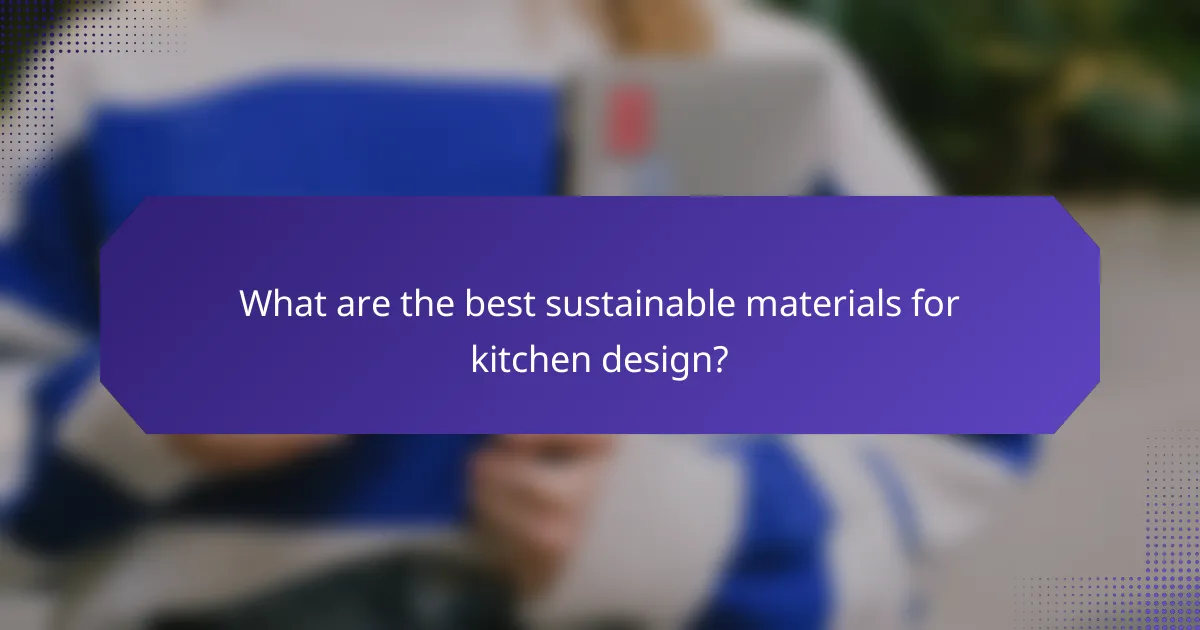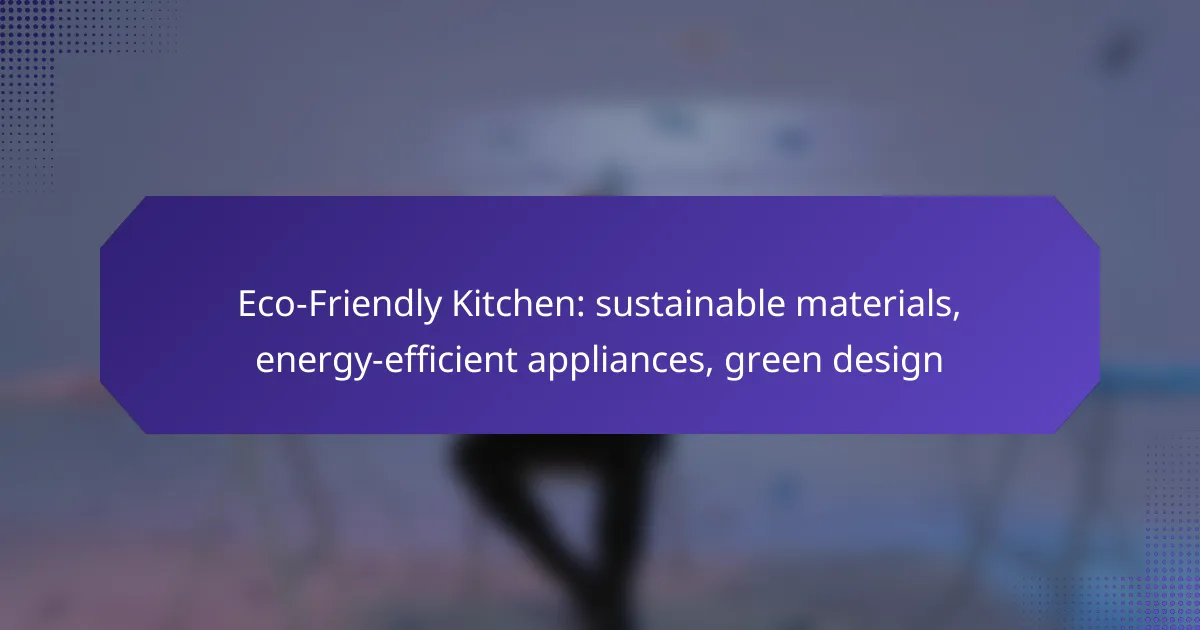Transforming your kitchen into an eco-friendly space involves choosing sustainable materials, incorporating energy-efficient appliances, and embracing green design principles. By selecting options like bamboo and recycled glass, you can create a stylish yet environmentally responsible kitchen. Additionally, investing in Energy Star certified appliances will help reduce energy consumption while enhancing your cooking experience.

How to create an eco-friendly kitchen in Canada?
Creating an eco-friendly kitchen in Canada involves selecting sustainable materials, using energy-efficient appliances, and designing for natural light and ventilation. These choices not only reduce environmental impact but can also enhance comfort and efficiency in your home.
Use sustainable materials like bamboo and recycled steel
Opting for sustainable materials is crucial for an eco-friendly kitchen. Bamboo is a popular choice due to its rapid growth and renewability, making it a strong and attractive option for cabinetry and flooring. Recycled steel is another excellent material, often used for countertops and appliances, as it minimizes waste and energy consumption in production.
When selecting materials, look for certifications such as FSC (Forest Stewardship Council) for wood products or LEED (Leadership in Energy and Environmental Design) standards for overall building materials. This ensures that your choices contribute positively to environmental sustainability.
Incorporate energy-efficient appliances from brands like Energy Star
Energy-efficient appliances significantly reduce energy consumption and utility bills. Look for appliances that have the Energy Star label, which indicates they meet strict efficiency guidelines set by the Canadian government. These appliances can save you a considerable amount on energy costs over their lifespan.
Consider upgrading to energy-efficient models for refrigerators, dishwashers, and ovens. For instance, modern dishwashers use about half the water of older models, while energy-efficient refrigerators can reduce energy use by up to 50%. Investing in these appliances not only benefits the environment but also enhances your kitchen’s functionality.
Design for natural light and ventilation
Designing your kitchen to maximize natural light and ventilation can significantly improve energy efficiency. Large windows, skylights, and open layouts allow sunlight to illuminate the space, reducing the need for artificial lighting during the day. This not only saves energy but also creates a more inviting atmosphere.
Incorporating proper ventilation is equally important. Use exhaust fans and strategically placed windows to promote airflow, which helps reduce humidity and odors. This can lead to a healthier kitchen environment and lower reliance on air conditioning, especially during warmer months.

What are the best sustainable materials for kitchen design?
The best sustainable materials for kitchen design include options that minimize environmental impact while providing durability and aesthetic appeal. Key materials like bamboo, recycled glass, and cork not only contribute to a greener kitchen but also enhance its functionality and style.
Bamboo for cabinetry and flooring
Bamboo is a highly renewable resource that grows rapidly, making it an excellent choice for cabinetry and flooring. It is strong, lightweight, and resistant to moisture, which is ideal for kitchen environments. When selecting bamboo products, look for those certified by the Forest Stewardship Council (FSC) to ensure sustainable sourcing.
Consider bamboo plywood for cabinetry, as it offers a modern look and is available in various finishes. For flooring, bamboo planks can be installed similarly to traditional hardwood, providing a warm aesthetic while being eco-friendly.
Recycled glass for countertops
Recycled glass countertops are made from post-consumer glass, which reduces waste and lowers the demand for new materials. These countertops are available in a variety of colors and textures, allowing for creative design options in your kitchen. They are durable and resistant to scratches and heat, making them practical for everyday use.
When choosing recycled glass, consider the percentage of recycled content and the manufacturing process. Some products may also incorporate resin, which can affect the environmental impact, so opt for those with lower resin content for a greener choice.
Cork for flooring and insulation
Cork is harvested from the bark of cork oak trees without harming the tree, making it a sustainable flooring option. It is naturally resistant to mold and mildew, providing a healthy environment in your kitchen. Cork flooring is also comfortable underfoot and offers excellent insulation properties, helping to maintain temperature and reduce energy costs.
For insulation, cork can be used in walls and ceilings, providing soundproofing and thermal benefits. When selecting cork products, look for those that are certified organic and free from harmful chemicals to ensure a truly eco-friendly choice.

Which energy-efficient appliances should I consider?
Consider energy-efficient appliances that significantly reduce energy consumption while maintaining performance. Key options include Energy Star certified refrigerators, induction cooktops, and high-efficiency dishwashers, which all contribute to a more sustainable kitchen environment.
Energy Star certified refrigerators
Energy Star certified refrigerators are designed to use less energy than standard models, often consuming 10-50% less electricity. When selecting a refrigerator, look for the Energy Star label, which indicates compliance with strict energy efficiency guidelines set by the U.S. Environmental Protection Agency.
In addition to energy savings, these refrigerators often come with features like improved insulation and advanced cooling technologies. Consider models with adjustable shelves and temperature controls to maximize space and efficiency.
Induction cooktops for efficient cooking
Induction cooktops are a highly efficient cooking option, using electromagnetic energy to directly heat pots and pans. This method reduces heat loss, making cooking faster and more energy-efficient compared to traditional gas or electric stoves.
When choosing an induction cooktop, ensure your cookware is compatible; it must be ferrous (magnetic). Look for models with multiple cooking zones and power settings for versatility in meal preparation.
High-efficiency dishwashers from Bosch
Bosch offers high-efficiency dishwashers that are known for their low water and energy consumption, often using less than 3 gallons of water per cycle. These models are designed to clean effectively while minimizing environmental impact.
When selecting a Bosch dishwasher, consider features like soil sensors and adjustable racks, which enhance cleaning efficiency. Look for models with the Energy Star certification to ensure you are making a sustainable choice.

What are the benefits of green kitchen design?
Green kitchen design offers numerous advantages, including enhanced energy efficiency, reduced environmental impact, and improved indoor air quality. By incorporating sustainable materials and energy-efficient appliances, homeowners can create a healthier living space while contributing to environmental conservation.
Reduced energy consumption
Implementing energy-efficient appliances and fixtures in a green kitchen significantly lowers energy consumption. For instance, Energy Star-rated appliances use about 10-50% less energy compared to standard models. Simple changes, such as using LED lighting and installing low-flow faucets, can further decrease energy usage.
To maximize energy savings, consider using smart technology that allows for better control over appliances and lighting. This can lead to more efficient use of resources, especially during peak energy times.
Lower environmental impact
Green kitchen design minimizes the environmental footprint by utilizing sustainable materials and reducing waste. Choosing products made from recycled or renewable resources, such as bamboo or reclaimed wood, helps conserve natural resources and reduces landfill contributions.
Additionally, opting for local materials can lower transportation emissions, further decreasing the kitchen’s overall environmental impact. This approach not only supports local economies but also fosters a more sustainable community.
Improved indoor air quality
Green kitchens contribute to better indoor air quality by using non-toxic materials and proper ventilation systems. Low-VOC (volatile organic compounds) paints, finishes, and cabinetry help reduce harmful emissions that can affect health.
Incorporating natural ventilation, such as windows and exhaust fans, can enhance air circulation, further improving air quality. Regular maintenance of appliances and ensuring proper airflow can also prevent the buildup of pollutants, creating a healthier kitchen environment.

How does eco-friendly kitchen design affect resale value?
Eco-friendly kitchen design can significantly enhance resale value by attracting buyers who prioritize sustainability. Features like sustainable materials and energy-efficient appliances not only improve a home’s appeal but can also lead to better financial returns.
Increased appeal to environmentally conscious buyers
An eco-friendly kitchen resonates with buyers who are concerned about environmental impact. These buyers often seek homes that reflect their values, making a green kitchen a strong selling point. Elements such as bamboo cabinetry, recycled countertops, and low-VOC paints can create a desirable aesthetic that aligns with sustainable living.
Additionally, showcasing energy-efficient appliances can further enhance appeal. Brands that emphasize eco-friendliness, such as Energy Star-rated products, signal to buyers that they will save on utility costs while reducing their carbon footprint.
Potential for higher resale prices
Homes with eco-friendly kitchens can command higher resale prices compared to traditional designs. Buyers are increasingly willing to pay a premium for features that promise long-term savings and environmental benefits. Reports suggest that homes with green certifications can sell for 5-15% more than similar homes without such features.
Investing in energy-efficient appliances and sustainable materials can yield a strong return on investment. For instance, while the initial costs may be higher, the long-term savings on energy bills and the increasing demand for sustainable homes can make these upgrades financially advantageous when it comes time to sell.










